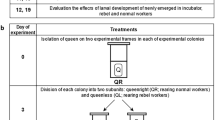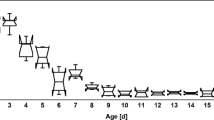Summary
The effects of worker age, brood stage and time of brood introduction or brood withdrawal on the hypopharyngeal (HP) gland activity of worker bees were examined. Worker age exerted a marked influence on gland activity. Only larvae affected HP gland activity, while eggs and pupae did not. Bees had inactive glands until their third day of larval feeding and they maintained high gland activity for approximately three days after larval removal. The data are congruent with the hypothesis that feeding behaviour itself causes gland activation, although the possibility that larvae produce a primer pheromone cannot be excluded.
Resume
On examine différents facteurs qui pourraient affecter l'activité des glandes hypopharyngiennes (HP) des ouvrières d'Abeille, tels que l'âge des ouvrières, les stades de développement du couvain et le moment d'introduction ou de retrait du couvain. L'âge des abeilles exerce une influence marquée sur l'activité des glandes HP; celle-ci est corrélée avec la croissance et la résorption des glandes décrites dans la littérature. Seules les larves sont aptes à activer les glandes HP, alors que les œufs et les nymphes ne le sont pas. Les glandes de l'abeille restent inactives pendant trois jours après le début du nourrissage des larves; elles conservent leur activité pendant trois jours environ après le retrait des larves. Ces données sont en accord avec l'hypothèse que c'est le comportement de nourrissage lui-même qui active les glandes; cependant, on ne peut exclure la possibilité que les larves produisent une phéromone stimulante.
Similar content being viewed by others
References
Brouwers E.V.M., 1982. — Measurement of hypopharyngeal gland activity in the honey-bees.J. Apic. Res., 21, 193–198.
Brouwers E.V.M., 1983. — Activation of the hypopharyngeal glands of honeybees in winter.J. Apic. Res., 22, 137–141.
Butler C. G., Fairey E. M., 1963. — The role of the queen in preventing oogenesis in worker honeybees.J. Apic. Res., 2, 14–18.
Fluri P., Lüscher M., Wille H., Gerig L., 1982. — Changes in weight of the pharyngeal gland and haemolymph titres of juvenile hormone, protein and vitellogenin in worker honey bees.J. Insect. Physiol., 28, 61–68.
Free J. B., 1967. — Factors determining the collection of pollen by honey bee foragers.Anim. Behav., 15, 134–144.
Freund R. J., Little R. C., 1986. —SAS for Linear Models: a Guide to the ANOVA and GLM procedures. (ed) Gary, NC. SAS Institute Inc. 231 pp.
Hassanein M. H., 1952. — The effects of infection withNosema, apis on the pharyngeal salivary glands of the worker honey bee.Proc. R. ent. Soc. Lond. 27A, 22–27.
Haydak M. H., 1957. — Changes with age in the appearance of some internal organs of the honeybee.Bee World., 38, 197–207.
Huang Z.-Y., 1988. —Mechanism of Hypopharyngeal Gland Activation by Brood of Honey bees (Apis mellifera L.). Ph. D. Dissertation, University of Guelph, 154 pp.
Huang Z.-Y., submitted. — A simplein vivo bioassay for estimating the hypopharyngeal gland activity in honey beesApis mellifera L. (Apidae, Hymenoptera).
Huang Z.-Y., Otis G. W., Teal P. E. A., in press. — Mechanism of Hypopharyngeal Gland Activation by Brood of Honey Bees,Apis mellifera (Apidae: Hymenoptera).
Jay S. C., 1970. — The effect of various combinations of immature queen and worker bees on the ovary development of worker honeybees in colonies with and without queens.Can. J. Zool., 48, 169–173.
Koeniger N., Veith H. J., 1983. — Glyceryl-1,2-dioleate-3-palmitate, a brood pheromone of the honeybee (Apis mellifera L.).Experientia, 39, 1051–1052.
Koeniger N., Veith H. J., 1984. — Spezifitat eines Brutpheromons und Bruterkennung bei der Honigbiene (Apis mellifera L.).Apidologie, 15, 205–210.
Kropacova S., Haslbachova H., 1971. — The development of ovaries in worker honeybees in queenright colonies examined before and after swarming.J. Apic Res., 9, 65–70.
Kulincevic J. M., Rothenbuhler W. C., 1973. — Laboratory and field measurements of hoarding behaviour in the honeybee.J. Apic. Res., 12, 179–182.
Maurizio A., 1950. — The influence of pollen feeding and brood rearing on the length of life and physiological condition of the honeybee.Bee World., 31, 9–12.
Michener C. D., 1974. —The Social Behavior of the Bees: a Comparative Study. Cambridge, Mass., Harvard Univ. Press., 404 pp.
Otto V. D., 1955. — Die Pharynxdrüse der Honigbiene (Apis mellifera L.) bei Prowona=Hefe=Nahrung als Pollennersatz.Archiv fur Geflügelzucht und Kleintierkunde.4, 209–240.
Ribbands C.R., 1953. — The Behaviour and Social Life of Honeybees.Bee Research Association Ltd., London, 352 pp.
Rösch G. A., 1925. — Untersuchungen über die Arbeitsteilung im Bienenstaat. I. Die Tätigkeiten im normalen Bienenstaate und ihre Beziehungen zum Alter der Arbeitsbienen.Z. Vergl. Physiol., 2, 571–631.
SAS Institute Inc., 1985. —SAS User's Guide: Statistics, Version 5, Editor, Gary, N.C., SAS Institute Inc., 956 pp.
Snodgrass R. E., 1956. —Anatomy of the honey bee. Comstock Publishing Associates, Cornell University Press, Ithaca, New York.XIV + 334 pp.
Soudek S., 1927. — Hltanove Zlazy Vcely Medonosne (The pharyngeal glands of the honey bee).Bull. Ecole Brno., 10, 1–63.
Author information
Authors and Affiliations
Rights and permissions
About this article
Cite this article
Huang, Z.Y., Otis, G.W. Factors determining hypopharyngeal gland activity of worker honey bees (Apis mellifera L.). Ins. Soc 36, 264–276 (1989). https://doi.org/10.1007/BF02224880
Received:
Accepted:
Issue Date:
DOI: https://doi.org/10.1007/BF02224880




